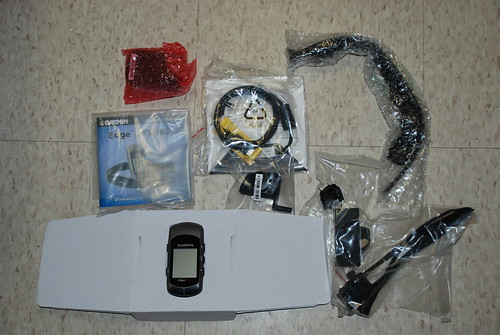This has been a long time coming, but I've finally logged enough miles and found enough time to write a review on my Garmin Edge 305 GPS cyclocomputer. There have been plenty of debates about the value of biking computers. Many find that riding without a cognizance of speed yields a more enjoyable experience than pouring over the minutiae of elevation and heart rate zones. An equal number seem to find great value in tracking their numbers over time. I fit into the second half. I'm not a racer but that doesn't mean I don't want my riding improve. It's tough to improve when you don't know where you're starting from. Having some numbers to compare from ride to ride has made a big difference in my cycling.
The 305 has an easy to read screen with plenty of information
The 305 comes in four different packages. The one I chose came complete with heart rate monitor and cadence sensor. Installation was a breeze. Since everything runs wirelessly, once all the components are mounted you're ready to ride. The toughest part was lining up the spoke and crank arm magnets with the cadence sensor. The 305 is fully featured, tracking the most important statistics a cyclist cares about. What separates it from it's big brother, the 705 is a lack of turn by turn mapping and power meter compatibility.
The 305 has a very compact size that fits well on a road bike stem. The screen is easy to read and all the buttons are fully accessible while riding. One of the big benefits of the 305 is the ability to customize the unit to exactly what you want. The main display can be changed to show up to six of the statistics the unit tracks simultaneously. If you still need more in-ride information, there is a second page that can also be fully customized.
The Garmin cadence sensor was the hardest part of a simple installation process
If you need a feature on the 305, it is likely there. In all fairness there are many which I don't use such as Virtual Training Partner and cadence alarms. However, I would like to highlight some of the features I find most useful. The first is the ability to program interval workouts into the computer based on either time or distance. Once programmed, the 305 makes an audible sound that signifies the beginning of each rest or effort interval. The inclusion of GPS also allows the user to set an auto-lap point which marks a new lap each time it's crossed.
Looking over my data over the past few months, I've seen both my average speed and cadence increasing steadily. Now that I can accurately measure laps and time, challenging myself to complete my home loop in faster times has pushed my fitness to higher levels. The ability to measure my cadence while climbing has helped me settle into a gear which strikes a balance between spinning and power. I can clearly see the improvement in my riding ability and I can feel the difference in my lungs and legs. Perhaps my improvement is due to more cycling experience, but either way I can now physically measure my improvements and that has been a help.
The entire Edge 305 package
Garmin provides an online data tracking system which users can download their ride data to. Garmin Connect is a website that allows Edge users to store their ride data and provides telemetry such as speed, heart rate, elevation, and cadence tracking. It also allows users to generate reports and see the routes other Garmin users are taking. Although there are other comprehensive data programs (such as Ascent and Sport Tracks) Garmin Connect is a great service that's free to Edge owners.
The 305 isn't without its faults. The lack of power meter compatibility means that if I want to add a system to measure my power output, I will need to upgrade to either the Edge 500 or 705. Since power is not measured, the calorie counting algorithms grossly exaggerate the calories burned by as much as 50%. Any discussion of the 305 would be remiss without mentioning the battery issues many users have faced. The message boards are full of owners wondering why their Edge 305 shuts off mysteriously mid-ride. The problem seems to be narrowed down to loose battery contacts and poor case design. To their credit, the Garmin folks have resolved these issues for the most part, but when spending close to $250 on a computer, it's a hassle that any prospective 305 user should be aware of. For the record, I've had my 305 for five months and over a thousand miles without a single issue. Buyers currently in the market for the 305 are in an unique position. Garmin has just introduced the Edge 500 which incorporates the 305's features into a smaller computer that's now compatible with power meters. The emergence of the 500 is a strong indication that the Edge 305 is probably on the way out. However, that's not necessarily a bad thing since it means the current 305 can likely be had for a deep discount.
The 305 is an outstanding entry into the world of GPS based cycling computers. As long as you're content to train without a power meter and ride familiar routes, the 305 is an exceptional value compared to the Edge 705. The bottom line, the 305's easy installation, the ability to download data to the computer, and precise gps measurements make it an outstanding bike computer. If you're interested in seeing your current ride numbers and how they change over time, there are few options better than the Edge 305.



No comments:
Post a Comment